We left Tuesday afternoon (October 31) and traveled until about 1 am. The trip took about nine hours, about two of which were spent passing through Mexico City. It really is incredible. To go almost anywhere in Mexico north of Puebla, you have to pass through Mexico City, literally. There is no highway that goes around the city, nor is there one that goes through it. To pass the DF you have to drive through the city, on the city streets with all the cars of people going to and from work or wherever. It's crazy! Mexico City is one of the largest cities in the world and it takes a LONG time to pass though. You feel like you're moving about 2 meters every 10 minutes. We watched an entire movie on the bus passing through the city, in both directions, coming and going.
Anyway, once we got to Morelia, we naturally slept until fairly late in the morning. We had most of the day free to wander the city. We visited a craft market and went to the cultural center to see an exhibit they had with artsy Day of the Dead offerings. Some of them were social commentaries and others were more poetic. It was neat to see alternative interpretations of the offerings.
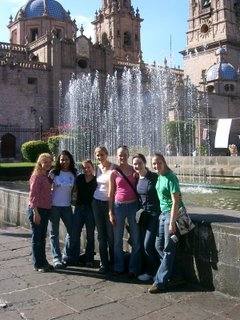
A group of us next to the cathedral in Morelia.
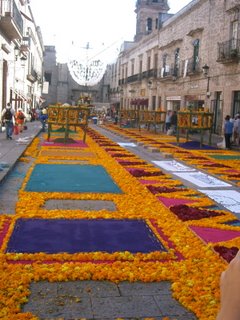
Huge, public offering in the center of Morelia.

One of the artsier offerings. It was called "Victoria's Secret"
At about five o'clock in the afternoon, we boarded a bus to begin our grand tour of Day of the Dead festivities. The biggest time for Day of the Dead celebrations is November 2 and the night before. The weeks leading up to the 2nd, families make altars in their houses to honor the family members who have died. The belief is that the family members' spirits will come back to spend a night and day with the family. There are different days for different types of deaths; children come back one day, people who died in an accident another, (there are more special days, but I don't know what they are), and then everyone else comes back the night between the 1st and 2nd and stay until 3 pm on the 2nd. The altars usually have three or four levels and each level is for a different thing. I think on the top level they put a cross, the second has a photo of the deceased person and traditional foods (day of the dead bread, mole, fruits, etc), and the bottom level has things the person liked, maybe more foods, tequila, cigarettes, toys, and such. Everything that's on the altar has a meaning and a purpose. I wish I could say I knew what they all were. All around and on the altar there are candles and yellow Day of the Dead flowers. The flowers are pretty strong smelling, so that combined with incense, which is often present, and the food, fill the whole house with a pretty interesting scent. The day the departed member is supposed to return, the living family spread petals between the altar and the front door, making a path for the spirit to follow.
The first Day of the Dead after someone dies is especially important. The family sets up the altar and then opens up their house for anyone in the community to come and share in the festivities. The night before the 2nd everyone stays up all night waiting, either in their houses or in the cemetery (where they also decorate the tombs with tons of flowers and candles). In the open houses, the women make tamales and a hot, corn, milk drink called atole, for everyone who comes to visit. The men also sometimes make a warm, alcoholic punch to share. It's amazing how the families can have so little money and yet can manage to make food and drink for anyone and everyone who comes to their house!
We started our excursion by visiting a small town to see the central altar in the small plaza. They were having an atole contest. All these women had pots of their best recipe there and judges were going around trying them and rating them. They had atole of pineapple, of corn from two different stages of its life, and others that I can't remember now. Paying 5 pesos (50 cents of the US dollar) we could try the atole and for 5 pesos more we could keep the beautiful, little painted pottery mugs it came in. We each got one and tried some of everyone’s. It's so delicious!!!
Next we went to a different village where the tourism company has some sort of agreement with the families. We saw the altars in the center of town and then got to visit houses and go inside to see the celebrations there. People were sitting around either in silence or chatting quietly in the room with the altar. In one house someone was playing the guitar. We got to try the warm punch in one house and in the other were given tamales and atole. It was really neat to see the women and girls all working around the huge stainless steel tubs of the corn mass for the tamales and stirring the huge tub of atole. It felt like something out of a movie, but it was real life.
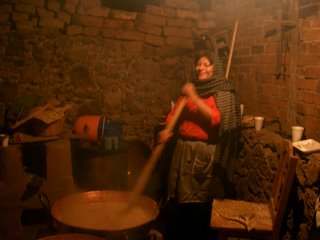
Woman stirring atole.
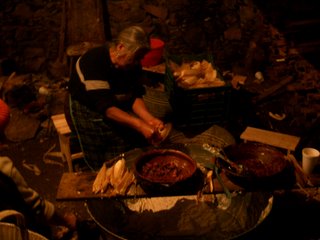
Woman making tamales.
After visiting the villages we went out to eat in a horrible restaurant. We were quite hungry, so it was disappointing. The food hardly tasted like anything and they kept running out of things. They say that when the family spirits come to a house to spend time with the family, they take the essence out of the food that the family has left for them. Some families don't eat the altar food after the Day of the Dead and some do, but those who do, say it doesn't taste the same. We decided that the reason the food in the restaurant had no taste was because all the dead who no longer have families in the area came to the restaurant and sucked all the essence out of the food; all we were left with was the form. So, in spite of the bad meal, we managed to have a good time making up stories and laughing a lot.
After dinner, we went to a cemetery to see how the offerings are done there. It was beautiful and surreal to be in a cemetery filled with candles, flickering fires, tons of flowers, and groups of people talking in hushed voices after midnight.

Cemetery filled with candles and flowers.

A tomb absolutely covered in flowers, with candles.
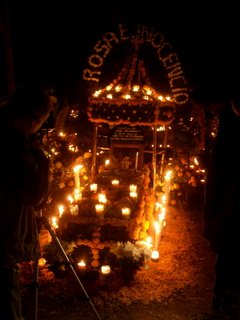
A large, elaborate offering at a tomb.
From there we went on to the most surreal part of our tour. We arrived at the lake of Patzcuaro, an enormous lake known for its Day of the Dead celebrations on its islands. We boarded a boat and set out for an island. After 40 minutes in the boat, moving through water covered with a few feet of fog, we arrived at the island. We briefly visited the altar in the church for all the people without families to decorate their graves and then we walked to the cemetery. The island and surrounding area are still filled with indigenous populations. In the cemetery we heard people talking purépecha, the indigenous language of the region. It was beautiful to be there. For me, what made the island so much more of a treat was that it was dark and I could see lots of stars. I walked most of the time with my eyes to the sky. It was fun trying to remember and pick out the constellations, sharing them with a couple friends on the trip.

People sleeping in the cemetery next to the tomb of their family.
At about 5:30 am we re-boarded the boats and started our long trek home. We arrived at the hotel after daybreak, at about 7 am. It was quite the night!
The next day we visited the ruins of Tzintzantzun, the capital of the Purépecha Empire. The purépechas lived at the same time as the Aztec empire. They were one of the only groups the Aztecs couldn't conquer. They were strong warriors and knew how to work silver and copper into weapons. Some historians say that if the Aztecs and Purépechas had united against the Spaniards, the history of Mexico might have been much different. However, they didn't unite and the Purépechas were defeated after the Aztecs. The ruins of their capital sit on top of a mountain next to a huge lake (possibly the same lake we were on the night before, but I'm not sure because the area is filled with lakes) surrounded by similar mountains. From there the leaders could see rest of the villages in their domain.
We also went to a small village where the people are known for their woodwork. We saw lots of furniture and other wooden objects. It wasn't a super interesting town, but I did buy quite a few picture frames so I could finally frame pictures to put around my room. It's nice to have more smiling faces of friends and family to look at each day now. I hope you are all well!
No comments:
Post a Comment